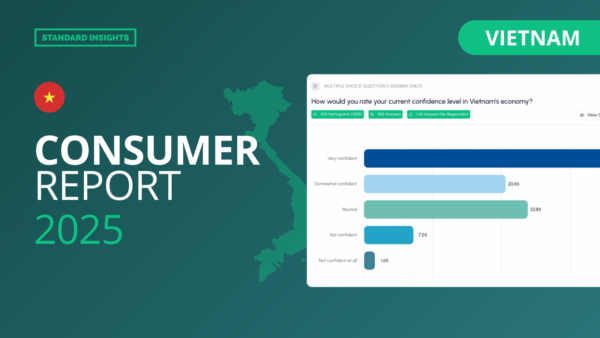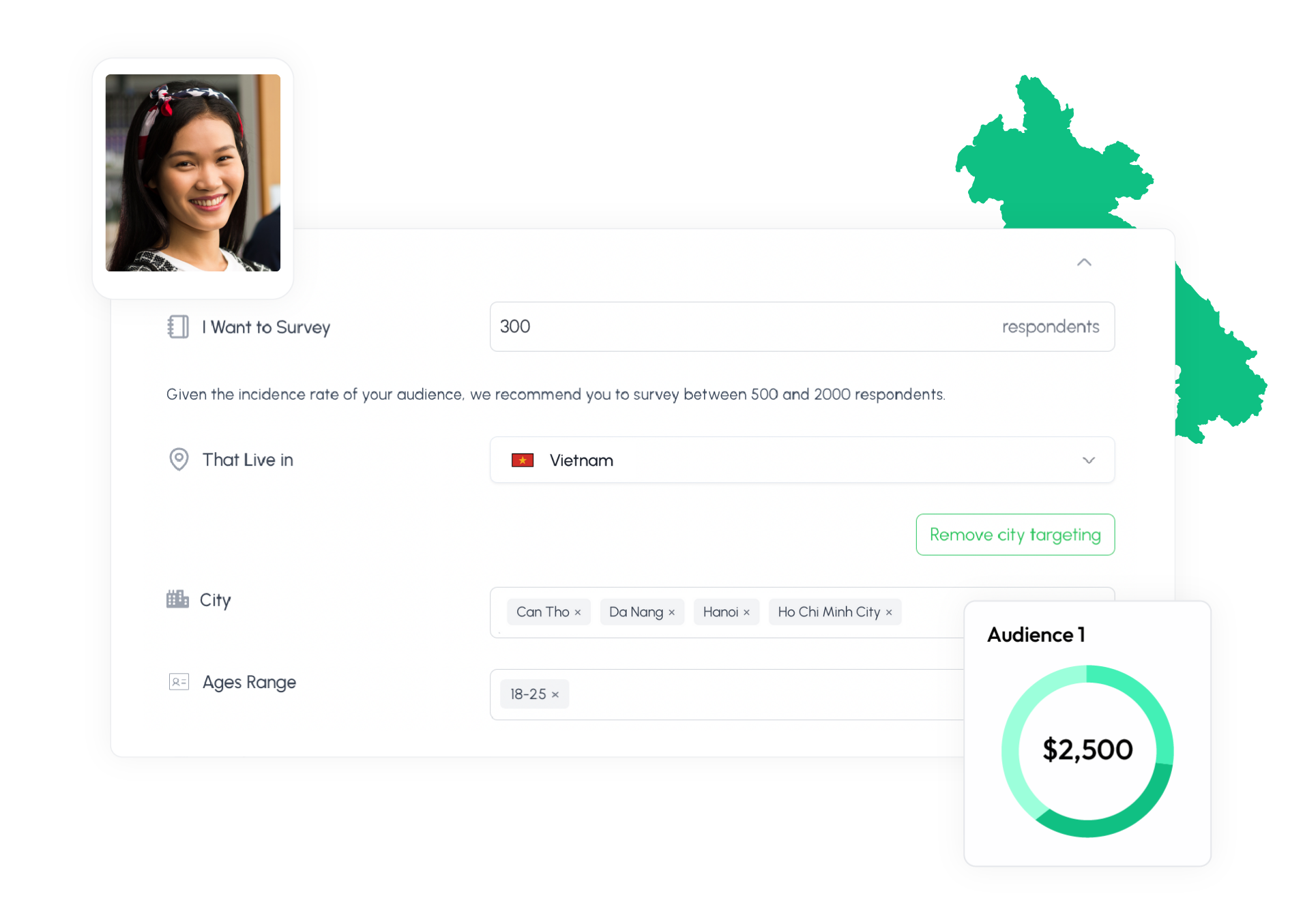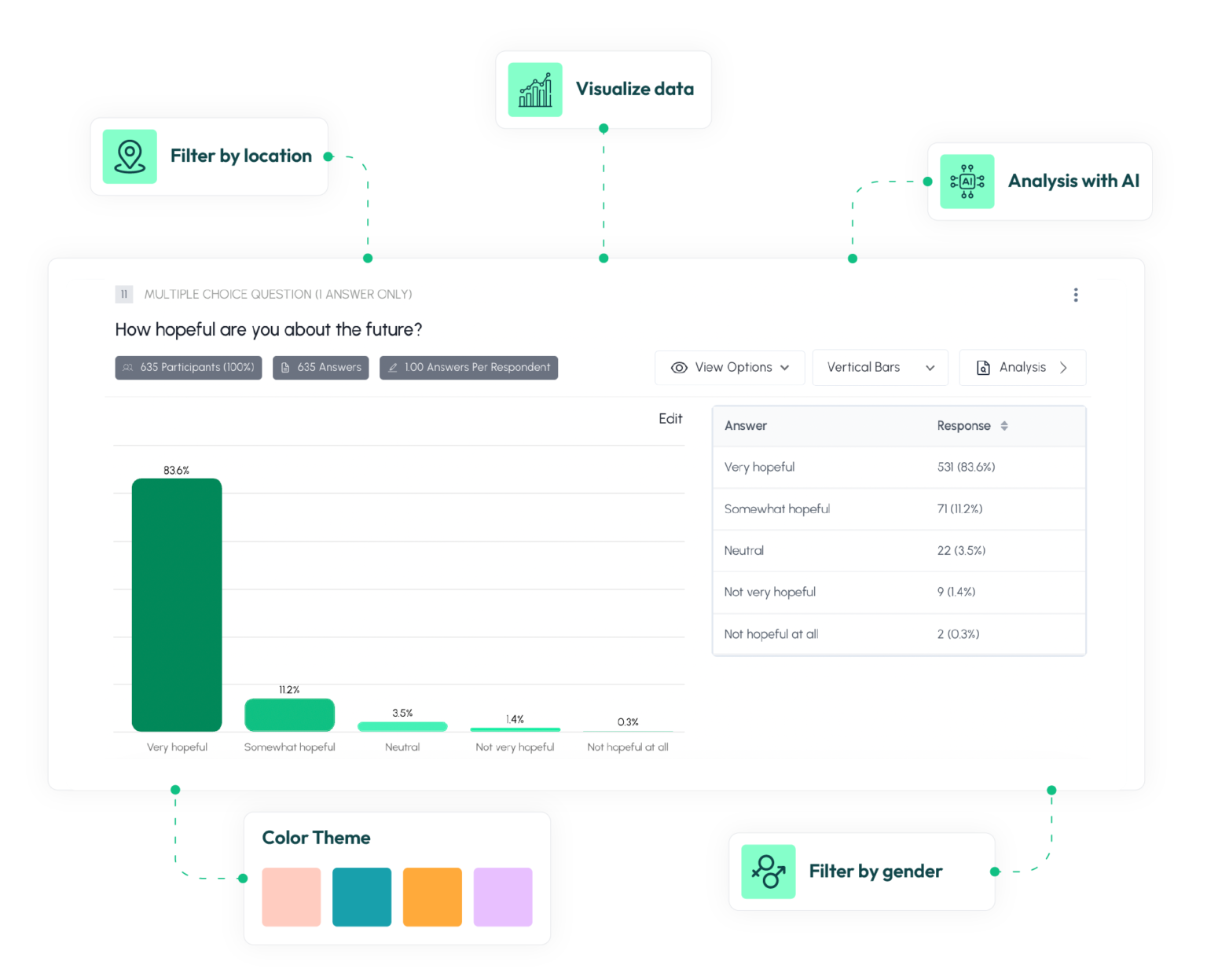
Consumer Report Vietnam 2025
Discover how Vietnam’s consumers navigated 2024 and their expectations for 2025 across key topics.
Begin your market research in Vietnam and easily collect, analyze, and report data with just a few clicks.
Trusted by

Use our survey builder to recruit respondents from anywhere in Vietnam or bring in your own respondents.


Import your existing surveys and interviews, and have them automatically visualized in a customizable report.

Gain access to the best quality respondents worldwide through our own methodology or vetted partners.

Conduct market research quickly: start a project in seconds, gather data in days, and create reports in clicks.

Enjoy our platform without any upfront commitments—pay only for the projects you undertake.
Vietnam is a Southeast Asian country located on the eastern part of the Indochinese peninsula. It shares its borders with China to the north, Laos to the west, Cambodia to the southwest, the East Sea to the east, and the Pacific Ocean to the east and south. The country stretches approximately 1,650 kilometers from north to south, with a maximum east-west extent of 500 kilometers.
Hanoi City
100.8 Million
$433.7 billion
Vietnam has achieved remarkable economic development since the launch of Đổi Mới in 1986, transitioning from one of the world’s poorest nations to a middle-income economy in just one generation. GDP per capita has risen significantly, reaching around $5,000 in recent years, and poverty rates have declined substantially, from 14% in 2010 to below 4% by 2020.
Despite challenges, Vietnam’s economy remains resilient. In 2024, GDP grew by 7.09%, driven by robust manufacturing and export recovery. For 2025, the government targets an ambitious growth rate of 8%, supported by strong foreign direct investment and strategic infrastructure development. Key sectors like manufacturing and tourism continue to fuel growth, while public investment reforms aim to address infrastructure gaps and sustain long-term economic momentum (World Bank report).
Vietnam has established itself as a significant player in global trade, supported by its diverse industries and strategic international partnerships. Key export sectors include electronics, textiles, footwear, machinery, and agricultural products such as rice and coffee. In 2024, Vietnam’s merchandise exports reached approximately US$405.53 billion, with electronics leading the way at US$72.6 billion, followed by phones and components at US$53.9 billion (Vietnam Briefing).
The United States remains Vietnam’s largest trading partner, with a trading volume of US$77 billion, while China follows closely at US$48.8 billion (World Bank). Vietnam also actively engages in major trade agreements such as the Comprehensive and Progressive Agreement for Trans-Pacific Partnership (CPTPP) and the Vietnam-EU Free Trade Agreement (EVFTA), which have propelled its export growth (HSBC Insights).
Vietnam’s tourism industry has experienced remarkable growth, becoming a vital sector of the economy. The country’s diverse landscapes, rich cultural heritage, and vibrant cuisine have made it a magnet for international travelers. Iconic destinations like Ha Long Bay, the ancient town of Hoi An, and the bustling streets of Hanoi offer a wide range of attractions and experiences.
In recent years, Vietnam has seen a significant surge in tourism. In January 2025, the country welcomed nearly 2.1 million international visitors, marking a 36.9% increase compared to the same period in 2024 and surpassing pre-pandemic levels by 37.8% (Vietnamnet). For 2025, Vietnam aims to attract between 25 to 28 million international visitors, exceeding the pre-COVID peak of 18 million in 2019 (B-Company). The government has implemented favorable visa policies, such as exemptions for citizens of Poland, Switzerland, and the Czech Republic, to boost European tourist arrivals (Vietnamnet). This strategic approach is expected to further enhance Vietnam’s position as a leading tourist destination in Southeast Asia.
Vietnam’s internet landscape has experienced significant growth in recent years, with an increasing number of internet users and improved infrastructure. As of early 2023, 79.1% of the population had internet access, marking a steady rise from previous years (Vietnam Internet Association). Internet users in Vietnam spent an average of six hours and 23 minutes per day online, showcasing high engagement with digital platforms (DataReportal). The country’s internet economy is projected to grow to $49 billion USD by 2025, driven by e-commerce and online travel (VietnamPlus).
The popularity and growth of social media in Vietnam can be attributed to widespread smartphone use and a strong internet infrastructure. As of January 2025, there were approximately 76.2 million social media users in Vietnam, making up 75.2% of the total population. This marks a notable increase from previous years.
Vietnam not only utilizes international platforms like Facebook and Instagram but has also developed successful local apps such as Zalo, which boasts a 92% penetration rate among internet users, and Viber, both of which are extensively used across the country and in Asia. Additionally, TikTok has gained significant traction, with around 40.9 million users aged 18 and above as of early 2025. The diverse social media landscape reflects Vietnam’s digital engagement and the growing importance of these platforms in everyday life.
Explore our previous reports from Vietnam to gain insights into consumer trends and behaviors

Discover how Vietnam’s consumers navigated 2024 and their expectations for 2025 across key topics.

In Vietnam, the alcoholic beverage industry is a lucrative and thriving business. Continue reading for a detailed overview of the landscape.

Take a break from your busy day, grab a cup of joe, and learn more about the coffee culture in Vietnam.
Create your free account and use our set of tools to conduct your research easily.